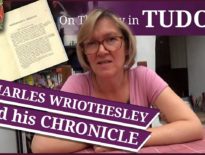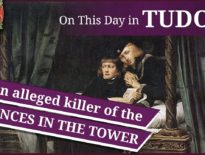On 7th May 1567, eight days before James Hepburn, Earl of Bothwell, married Mary, Queen of Scots, the Catholic court granted him a divorce from his wife, Lady Jean Gordon.
Who was Jean Gordon? Why did Bothwell divorce her? And what happened to Jean afterwards?
Find out more about Bothwell and Jean's marriage, and about Jean's life, in today's talk.
My video for 29th April:
And my video on Bothwell's death:
Also on this day in Tudor history, 7th May 1535, after a year of imprisonment in awful conditions at the Tower of London, John Fisher, former Bishop of Rochester, was visited at the Tower of London and tricked into saying something that would lead to his brutal end. Find out more in last year’s video:
And on this day in 1536, in the fall of Anne Boleyn, the queen’s chaplain was accosted and searched on his arrival back in England from the Continent. Why? Find out in last year’s video:
Also on this day in history:
- 1540 – Death of Sir William Weston, Prior of the Hospital of St John of Jerusalem in England. He died at the priory on the day that the order to dissolve it was passed through the Commons. He was the uncle of Sir Francis Weston, a man executed in 1536 in the coup against Anne Boleyn.
- 1547 – Death of John Longland, Bishop of Lincoln, at Wooburn. He had requested that his body be buried at Eton College and his heart in the cathedral church at Lincoln.
- 1560 – English troops charged the wall of Leith at the siege of Leith. They were unsuccessful and suffered heavy losses.
- 1592 – Death of Sir Christopher Wray, judge, Chief Justice of the King's Bench and Speaker of the House of Commons. He was buried at St Michael's Church, Glentworth, Lincolnshire.
- 1594 – Death of Edmund Scambler, Bishop of Peterborough and Norwich, at Norwich. He was buried in the cathedral, but his tomb was destroyed in the Civil War.
- 1603 – James VI/I arrived in London after travelling from Edinburgh to claim the English throne. His predecessor, Elizabeth I, had died on 24th March.
Transcript:
On 7th May 1567, eight days before James Hepburn, Earl of Bothwell, married Mary, Queen of Scots, the Catholic court granted him a divorce from his wife, Lady Jean Gordon, on the grounds of consanguinity, with the couple having been related in the fourth degree.
This annulment, or divorce, the terms are used interchangeably by historians when talking about this time, was granted at the request of Mary, Queen of Scots, as Bothwell was determined to marry her, and a Protestant court had already annulled the marriage on 3rd May due to Bothwell’s adultery with his wife’s maid.
I explained the background to this in my video from 29th April, which I’ll give you a link to, but today I want to talk about Bothwell and Lady Jean Gordon.
Jean was born in around 1546 and was the daughter of Scottish nobleman George Gordon, 4th Earl of Huntly, and his wife, Elizabeth Keith. Her father and two of her brothers and the Clan Gordon rebelled against Mary, Queen of Scots in 1562 and her father died at the Battle of Corrichie against the Earl of Moray, dying of a stroke rather than battle wounds. Following Moray’s victory, Jean’s brothers involved in the battle were executed and her father was attainted posthumously for treason. Fortunately for Jean, the queen didn’t hold this rebellion against the family and by 1565 Jean and her mother were serving the queen at court, and her eldest brother, George, was restored to her father’s earldom in 1565 and restored to the Gordon lands in 1567.
Jean fell in love with Alexander Ogilvy, laird of Boyne, but, on 22nd February 1566, Jean, who was a Catholic, married James Hepburn, Earl of Bothwell, a friend of her brother George, in a ceremony at Holyroodhouse. The ceremony was presided over by Jean’s uncle, Alexander Gordon, Bishop of Galloway, who was a Protestant. This was because Bothwell refused to have a Catholic service. Mary, Queen of Scots, was heavily involved in the marriage, signing the marriage contract on 12th February 1566 and giving Jean twelve ells of cloth of silver to make her wedding dress. John Hamilton, Archbishop of St Andrews had granted a dispensation to cover consanguinity on 17th February.
Jean and Bothwell set up home at Crichton Castle in Midlothian, but the marriage was shortlived as Jean’s husband was determined to marry Mary, Queen of Scots. As I explained in my talk from 29th April, Bothwell persuaded Jean to begin a suit for divorce on the grounds of adultery while he, with Mary’s help, sought one on the grounds of consanguinity even though a dispensation had been granted just a year earlier. The queen definitely used her influence there!
Bothwell married Mary on 15th May 1567, and in 1573, Jean married Alexander Gordon, twelfth earl of Sutherland, and settled with him at Dunrobin Castle. They went on to have seven children together before Sutherland’s death in 1594. In 1599, Jean married her first love, Alexander Ogilvy, and they were married for ten years, before Ogilvy died. Jean’s eldest son, who had inherited the Sutherland lands from his father, died in 1615, so Jean took over the estates while bringing up her grandson, who became the earl on his father’s death.
In Protestant Scotland, Jean held firm to her Catholic faith and in 1627, when Jean was about eighty-one she was excommunicated for harbouring Jesuit priests. Two years later, on 14th May 1629, eighty-three year old Jean died. She was buried with her second husband at Dornoch Cathedral.
Her son, Robert, described her as “a virtuous and comelie lady… of great understanding above the capacitie of her sex” so I’m glad she ended up with her first love, a happy end to her life.
Her first husband, the Earl of Bothwell, though, ended his days in a Danish prison, where he was held in appalling conditions and driven insane.



Leave a Reply